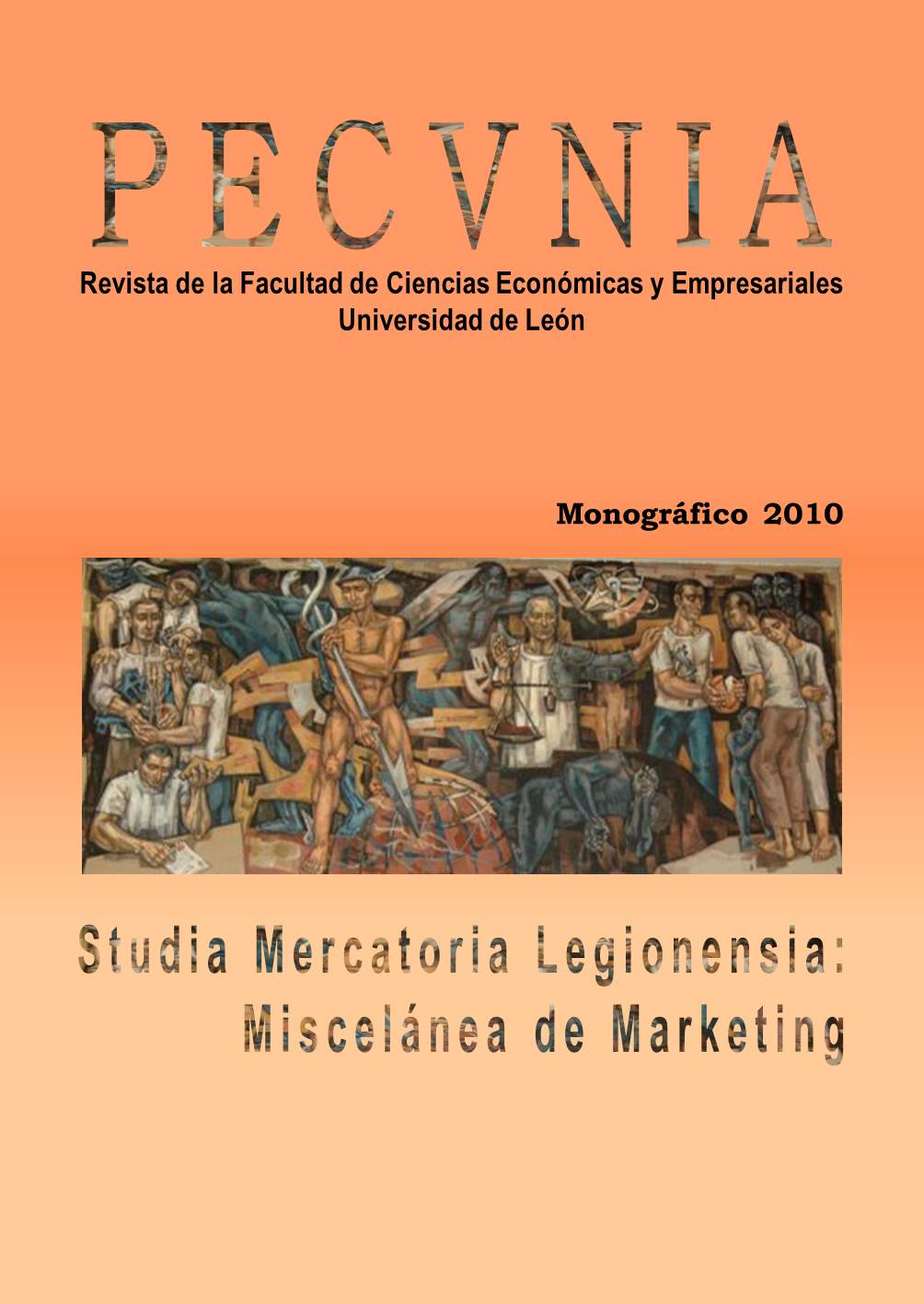Consumers’ first impressions of consumption environments: a cultural perspective
DOI:
https://doi.org/10.18002/pec.v0i2010.765Palavras-chave:
Primera impresión visual, Entorno de consumo, Cultura, Visual first impression, Consumption environment, CultureResumo
El propósito de este trabajo es analizar las diferencias culturales entre los consumidores finlandeses y españoles en lo que respecta a los aspectos visuales de los entornos de consumo. El texto aborda estas cuestiones mediante la ampliación del análisis de la percepción de los consumidores de las claves del entorno al estudio de la experiencia de los entornos de consumo. El objeto de este artículo es, en primer lugar, analizar los generadores de las primeras impresiones visuales en el consumidor y, en segundo lugar, estudiar el mecanismo de aproximación-evitación al evocar la dimensión de los entornos visuales. Los datos se recogieron mediante entrevistas personales en Finlandia y España. Se mostraron seis fotos de interiores de cafés a 200 encuestados de Finlandia y a otros 200 encuestados de España. A los encuestados se les pidió que eligieran el café al que les gustaría y al que no les gustaría ir y después decir por qué lo habían elegido. En el artículo se explica la forma en que los generadores de las primeras impresiones visuales (rasgos distintivos, estilo, atmósfera, funcionalidad y accesibilidad) se relacionan con los cuatro mecanismos de aproximación-evitación al evocar las dimensiones de los entornos visuales (percibir, pensar, sentir y actuar) Los resultados iniciales indican cómo una misma dimensión evaluativa puede producir tanto conductas de aproximación como de evitación. En el documento se señalan y analizan las diferencias culturales en lo que se refiere a las estimaciones de los consumidores y a la interpretación de los entornos visuales.The purpose of this paper is to analyze cultural differences between Finnish and Spanish consumers with regard to the visual aspects of consumption environments. The paper approaches these issues by extending the analysis of consumers’ perception of environmental cues to the analysis of the experiencing of consumption environments. The objectives of this paper are first to examine what are the creators of consumers’ visual first impressions, and second to examine the approach and avoidance evoking dimensions of visual environments. The data was collected with personal interviews in Finland and Spain. Six photos of the interiors of cafés were shown to 200 respondents from Finland and to 200 respondents from Spain. The respondents were asked to select the café where they would like and would not like to go, and then to say why they had chosen them. The paper discusses how the creators of visual first impressions (distinctive features, style, atmosphere, functionality and accessibility) are related to the four approach and avoidance evoking dimensions of visual environments (the sense, think, feel, and act type of experiences). The initial findings indicate how a same dimension of evaluation could evoke both approach and avoidance behavior. The paper points out and discusses the cultural differences in consumers’ evaluations and interpretations of visual environments.
Downloads
Referências
Aubert-Gamet, V. and Cova, B. (1999). “Servicescapes: From modern non-places to postmodern common places”. Journal of Business Research, vol. 44, n. 1, pp. 37- 45.
Babin, B.J. and Attaway J.S. (2000). “Atmospheric affect as a tool for creating value and gaining share of customer”. Journal of Business Research, vol. 49, n. 2, pp. 91-99.
Baker, J.; Parasuraman, A.; Grewal D. and Voss, G.B. (2002). “The influence of multiple store environmental cues on perceived merchandise value and patronage intentions”. Journal of Marketing, vol. 66, n. 2, pp. 120-141.
Belk, R.W. (1975). “Situational variables and consumer behavior”. Journal of Consumer Research, vol. 2, n. 3, pp. 157-164.
Belk, R.W. (1980). “Effects of consistency of visual consumption patterns on impression formation”. Advances in Consumer Research, vol. 7, n. 1, pp. 365-371.
Bellizzi, J.A.; Crowley, A.E. and Hasty, R.W. (1983). “The effects of color in store design”. Journal of Retailing, vol. 59, n. 1, pp. 21-45.
Bellizzi, J.A. and Hite, R.E. (1992). “Environmental color, consumer feelings, and purchase likelihood”. Psychology and Marketing, vol. 9, n. 5, pp. 347–363.
Bianchi-Berthouze, N. (2002). “Mining multimedia subjective feedback”. Journal of Intelligent Information Systems, vol. 19, n. 1, pp. 43-59.
Bitner, M.J. (1992). “Servicescapes: The impact of physical surroundings on customers and employees”. Journal of Marketing, vol. 56, n. 2, pp. 57-71.
d`Astous, A. (2000). “Irritating aspects of the shopping environment”. Journal of Business Research, vol. 49, n. 2, pp. 149-156.
Demarais, A. and White, V. (2005). First impressions: What you don't know about how others see you. London: Hodder and Stoughton Ltd.
Donovan, R.J. and Rossiter, J.R. (1982). “Store atmosphere: An environmental psychology approach”. Journal of Retailing, vol. 58, n. 1, pp. 34-57.
Elliott, R. (1998). “A model of emotion-driven choice”. Journal of Marketing Management, vol. 14, n. 1/3, pp. 95-108.
Gilboa, S. and Rafaeli, A. (2003). “Store environment, emotions and approach behaviour: Applying environmental aesthetics to retailing”. The International Review of Retail, Distribution and Consumer Research, vol. 13, n. 2, pp. 195-211.
Gladwell, M. (2005). Blink. The power of thinking without thinking. New York: Little, Brown and Co.
Greenacre, M. and Jörg, B. (1994). Correspondence analysis in the social sciences.
Recent developments and applications. London: Academic Press.
Herzog, T.R.; Kaplan, S. and Kaplan, R. (1982). “The prediction of preferences for unfamiliar urban places”. Population and Environment, vol. 5, n. 1, pp. 43-59.
Holbrook, M.B. (2000). “The millennial consumer in the texts of our times: Experience and entertainment”. Journal of Macromarketing, vol. 20, n. 2, pp. 178-192.
Holbrook, M.B. and Hirschman, E.C. (1982). “The experimental aspects of consumption: Consumer fantasies, feelings, and fun”. Journal of Consumer Research, vol. 9, n. 2, pp. 132-140.
Kaplan, S. and Kaplan, R. (1983). Cognition and environment. Functioning in an uncertain world. Ann Arbor, MI (EE.UU): Ulrich’s.
Kenhove, P. Van and Desrumaux, P. (1997). “The relationship between emotional states and approach or avoidance responses in a retail environment”. The International Review of Retail, Distribution and Consumer Research, vol. 7, n. 4, pp. 351-368.
Kumar, V. and Karande, K. (2000). “The effect of retail store environment on retailer performance”. Journal of Business Research, vol. 49, n. 2, pp. 167-181.
Laaksonen, P. (1994). Consumer involvement: Concepts and research. London: Routledge.
Laaksonen, P.; Laaksonen, M. and Huuhka, A. (2006). “Visuaalinen ensivaikutelma– jäsennys kulutuskontekstin houkuttelevuudesta ja sen torjunnasta”. Kuluttajatutkimus. Nyt-verkkolehti, n. 1, pp. 1-17.
Levy, M. and Weitz, B.A. (2004). Retailing management. New York: McGraw-Hill.
MacInnis, D. and Price, L. (1987). “The role of imagery in information processing: 89
Review and extensions”. Journal of Consumer Research, vol. 13, n. 4, 473-491.
MacLaran, P. and Brown, S. (2005). “The center cannot hold: Consuming the utopian marketplace”. Journal of Consumer Research, vol. 32, n. 2, pp. 311-323.
Mehrabian, A. and Russell, J.A. (1974). An approach to environmental psychology. Cambridge: The Massachusetts Institute of Technology.
Morrin, M. and Ratneshwar, S. (2000). “The impact of ambient scent on evaluation, attention, and memory for familiar and unfamiliar brands”. Journal of Business Research, vol. 49, n. 2, pp. 157-165.
Ritterfeld, U. and Cupchik, G.C. (1996). “Perceptions of Interior Spaces”. Journal of Environmental Psychology, vol. 16, n. 4, pp. 349-360.
Rosenbaum, M.S. (2005). “The symbolic servicescape: Your kind is welcomed here”. Journal of Consumer Behaviour, vol. 4, n. 4, pp. 257-267.
Schmitt, B. (1999). "Experiential marketing”. Journal of Marketing Management, vol. 15, n. 1-3, pp. 53-67.
Solomon, M.R. (2006). Consumer behavior. Buying, Having and Being. Upper Saddle River, NJ: Pearson Education, Inc.
Solomon, M.R. (1983). “The role of products as social stimuli: A symbolic interactionism perspective”. Journal of Consumer Research, vol. 10, n. 3, pp. 319- 329.
Downloads
Publicado
Como Citar
Edição
Secção
Licença
Direitos de Autor (c) 2010 Pirjo Laaksonen, Martti Laaksonen, Ari Huuhka, Carmen Rodríguez Santos

Este trabalho encontra-se publicado com a Licença Internacional Creative Commons Atribuição-NãoComercial-CompartilhaIgual 4.0.
Los autores que publican en esta revista están de acuerdo con los siguientes términos:- Los autores ceden de forma no exclusiva los derechos de explotación (reproducción, distribución, comunicación pública, transformación) a la Universidad de León, por lo que pueden establecer, por separado, acuerdos adicionales para la distribución no exclusiva de la versión de la obra publicada en la revista (por ejemplo, alojarlo en un repositorio institucional o publicarlo en un libro), con un reconocimiento de su publicación inicial en esta revista.
- Este trabajo se encuentra bajo la Creative Commons Attribution-NonCommercial-ShareAlike 4.0 International License. Puede consultarse desde aquí la versión informativa y el texto legal de la licencia.
- Se permite y se anima a los autores a difundir electrónicamente las versiones pre-print (versión antes de ser evaluada) y/o post-print (versión evaluada y aceptada para su publicación) de sus obras antes de su publicación, ya que favorece su circulación y difusión más temprana y con ello un posible aumento en su citación y alcance entre la comunidad académica.












